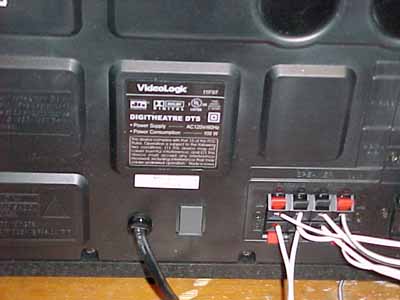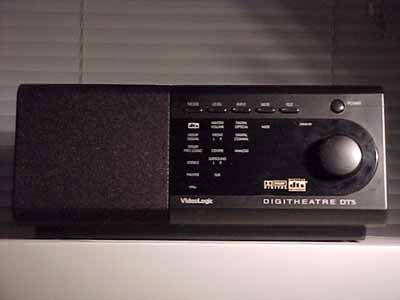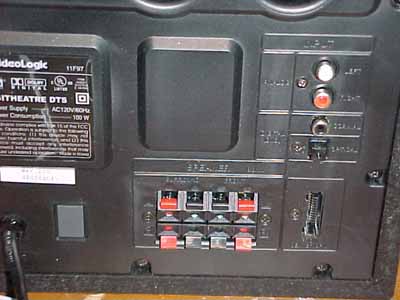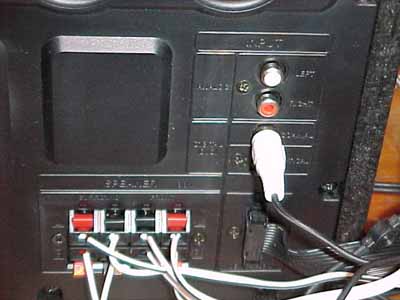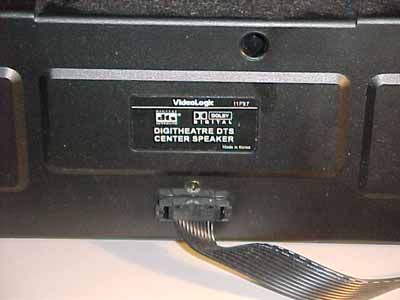
Original Link: https://www.anandtech.com/show/739
VideoLogic DigiTheatre DTS: The Ferrari of Sound is here
by Jim Warren on March 19, 2001 12:30 AM EST- Posted in
- Smartphones
- Mobile
Introduction
Entertainment has always developed off the shoulders of technology. From the development of paint and textiles came artwork; likewise, photography came from new optics technology and chemistry. Advances in electronics brought the pictures alive, and sound soon was tied to the moving pictures. That pretty much brings us into the first half of the last century. Television and video brought a new measure of reality to communication, serving as the history behind the computers that are easily described as pervasive these days. Though many of these milestones were visually based in pictures, sound has been there most of the time as well. Each step of sound technology both keeps up with and greatly enhances each step in visual technology.
The step from mono to stereo introduced the concept of directionality to sound, or as some would argue, the concept of realism. More directional technologies were seen first in the theatre with multitrack playback for movies. As the video technology moved down to the consumer level, the multitrack audio needed to follow. Out of this came the Dolby encoding techniques that brought the surround info to the home. Add on the ProLogic processing algorithms, and the center track was extracted from the mix for everyone to enjoy. Finally, Dolby Digital upped the bar by bringing 5 full range tracks plus a low frequency effects channel to the audience.
For those that were looking for a little more from theatre sound, Jurassic Park premiered an exciting new option. DTS, a format developed by Digital Theatre Systems, Inc. offers a 6 channel format similar to that of Dolby Digital. However, it is designed with less compression in an attempt to preserve more of the original multitrack master. The result? A wider dynamic range that gives more artistic room to play with; essentially, explosions can be louder, or a whisper more discrete, in the same movie. Progress is here, so it’s time to sit back and listen.
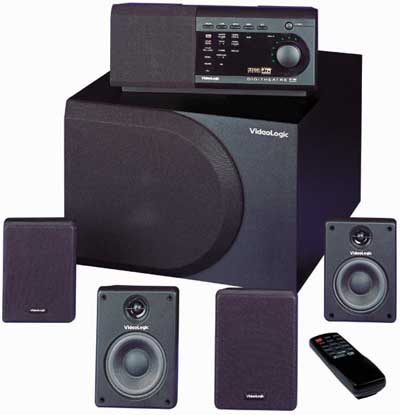
The VideoLogic DigiTheatre DTS system consists of four satellites, plus a center speaker integrated into a control module for the system. The subwoofer contains the amplifiers for the system. The satellites come in plastic enclosures, while the sub resides in a MDF wooden enclosure. As the name implies, it supports DTS surround and is also backwards compatible with Dolby Digital and Dolby ProLogic. Here’s what VideoLogic says about the system:
CENTRE SPEAKER / CONTROLS
Fully magnetically shielded 100mm/3.94 inch bass/mid frequency drive unit with concentric high-frequency tweeter.
Remote control: Infra-red remote control functions include standby mode on/off, surround mode select, volume (master and individual channels), input select, mute and test tone.
Surround modes: DTS, Dolby Digital (5.1), Dolby Pro Logic, plus ‘Theatre’ and ‘Hall’ modes for stereo material.
Volume level: Master and individual volume control for each speaker.
Input select: Digital optical, digital coaxial or analog line in.
AMPLIFIER/SUBWOOFER
MDF wooden cabinet, containing magnetically shielded drive unit.
Low frequency drive unit: 200mm/8 inch long-throw subwoofer.
Power output: Satellites: 4 x 30W RMS.
Centre speaker: 30W RMS. Subwoofer: 70W RMS. Total system: 220W RMS.
Input connectors: Coaxial (RCA phono) and optical (Toslink) connectors for digital (S/PDIF) input. Dual coaxial (RCA phono) for analog stereo input.
Power supply: UK/Europe 220-240V AC 50/60Hz; USA/Canada 110-120V AC 50/60Hz.
FRONT & SURROUND SPEAKERS
Cabinets manufactured from mica-loaded polymer containing magnetically shielded Audax drive units. Includes bracket-mounting holes and removable grilles (brackets available separately from www.videologic.com).
Bass/mid frequency drive: Audax 80mm cone.
High frequency drive: Audax 10mm polymer dome tweeter.
GENERAL
Cables supplied: Serial cable (for connecting centre speaker decoder unit to subwoofer); S/PDIF RCA phono cable (male to male); 3.5mm to dual phono cable; multistrand cable for front and surround speakers.
Approvals: CE marked. Compliant with the EMC and Low Voltage Directives (89/336/EEC and 73/23/EEC). UL approved.
Dimensions (width / height / depth): Front and surround speakers: 100 x 136 x 79mm; 3.94 x 5.35 x 2.91 inches. Centre speaker: 303 x 132 x 152mm; 11.93 x 5.2 x 5.98 inches. Subwoofer: 350 x 245 x 400mm; 13.78 x 9.65 x 15.75 inches.
Weight: Approx. 17kg/38lbs.
Technical support: Telephone support hotline and Internet web site.
Warranty: Two years.
The Setup
The system packs into a surprisingly small box, though its weight indicates that it has the mass to back up its power. It unpacks quickly; the parts list is fairly straightforward. There are four satellite speakers, a control module with an integrated center speaker, the subwoofer, and finally cabling that includes 4 speaker wires and a multipin control cable.

The system comes with placement recommendations designed to help replicate the surround format that DTS program material is mixed for. It suggests an isosceles triangle (equidistant sides) with the user at the vertex, and an apex angle of 70 degrees.

Further layout instructions are included for aligning the center speaker with the front surrounds. They should be in the same horizontal plane (i.e. at the same height), and the center speaker should be even with or slightly behind the vertical plane of the front surrounds. These all should be oriented with the center channel as close to the visual source as possible.

Finally, there are two placement options for the rear surrounds. They should be approximately 2 to 3 feet (60-90 cm) above ear level, and placed so that they either shoot straight across the back wall at each other (the recommendation from VideoLogic), or straight along the side walls.
Once the satellites have been placed, they are wired to the amplifier integrated into the subwoofer enclosure. Four speakers cables are included, two of which are longer and designed for the rear surrounds. All connections are via spring loaded terminal strips, so in the event that the provided lengths are not long enough, any standard speaker wire can be substituted to achieve the desired length for the four satellites.
The Setup (continued)
The control unit for the system is part of the center speaker enclosure, and should be placed at the visual source. The subwoofer then has to be placed within ten feet of this unit, as there is a proprietary multipin connection between the two that cannot be extended with readily available materials. If absolutely needed, an extension is available from VideoLogic in the United Kingdom. This multipin connection is what connects the amplifier to the control module, as well as providing the speaker feed for the center channel.
There is some freedom in where the subwoofer can be placed, as bass frequencies are omnidirectional. The easiest location is on the floor; the unit can even be tucked under furniture as needed within the limiting distance of the cable connections. If the sub is backed up into a corner or at the edge of a wall and then floor, it will increase the bass effects as reflections direct more of the sound to the room.
The unit has a variety of input options for connecting to source material. SPDIF connections are available via both optical (TOSLINK) and coaxial connections. Included in the package is a digital coaxial cable, though an optical cable is not included. Both digital connections support both Dolby Digital and DTS decoding. The third connection option is an analog stereo connection. Each input is individually selectable at the control module, though the physical connections are made to the amplifier that is integrated into the subwoofer enclosure. Included with the system is a stereo RCA to minijack cable, and a normal stereo RCA cable for interfacing to other equipment.
Though not specifically described in the users manual, the connection included for the analog connection (minijack to stereo RCA) can be used to make the digital coaxial connection to most sound cards. The connection on most sound cards is via a minijack in order to save space; the center pin of the jack referenced to shield will provide the digital signal. These pins can be accessed via the left connection in the stereo RCA to minijack adaptor. This way, there is no need to buy an extra cable to make the system go together.
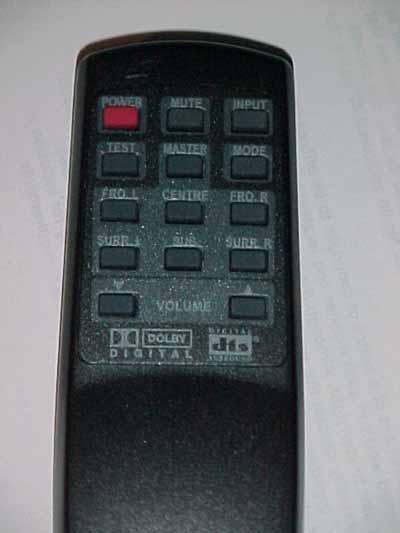
The final connection is power. For the units sold in the US, it’s a direct connection to 120V power. Units sold in Europe are wired for UK power, and include a power adaptor for other regions. Once the system is energized, the wireless remote can be checked for operation, and then it’s time to get things going and sit back and listen.
The Sound
VideoLogic’s history of consistent sound quality is clearly evident in the design of the DigiTheatre DTS. The system deserves examination from two standpoints - the first is the acoustics of the individual components and as they work in unison; the second is the decoding options and how they combine to accentuate the system.
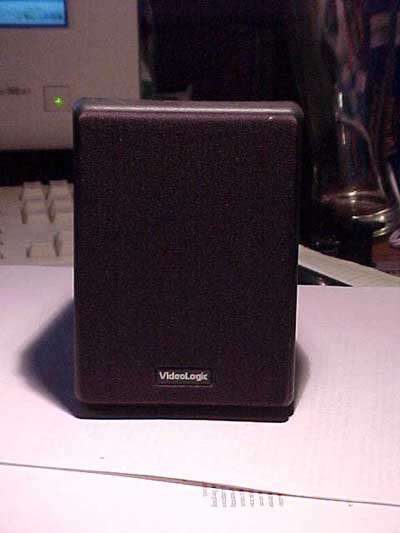
The satellites speakers in the system bear a strong resemblance to those of VideoLogic’s older system, the Sirocco Crossfire 4.1 system. They consist of two drivers, a step rarely taken in computer speaker systems. Diversification allows for specialization - it’s a classic concept that can also be applied to speakers. By allowing the midrange driver to concentrate on quality reproduction of lower frequencies, VideoLogic has averted the midrange dip that plagues computer speakers around their crossover frequency between satellites and subwoofer. The 10mm tweeters also help reign in highs to maintain clarity; they don’t get quavery or distorted by a driver having to stretch to reproduce low frequencies at the same time.
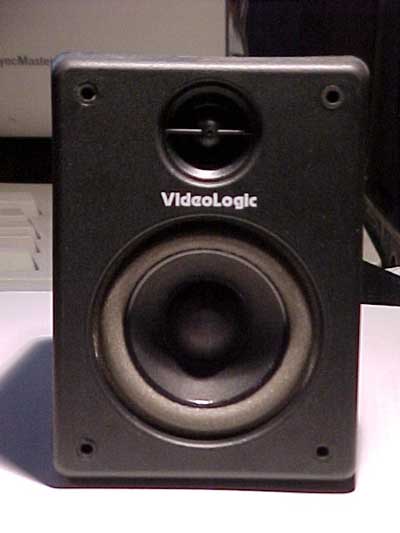
The center channel of the system is designed mostly to handle voice replication. It uses a coaxial driver, which stacks the high frequency transducer in the center of the bass/mid driver. This helps align the sound for the directional nature of the center channel; it is there to localize vocals to the visual source. The unit definitely is designed for the vocal frequencies. As such, it isn’t as musical as the other channels, but more than sufficient for the DTS reproduction.
The Sound (continued)
The subwoofer is an impressive unit; the 8 inch driver definitely moves its share of air. The system exhibits an impressive frequency response that reaches down into the lowest frequencies. Oftentimes, subwoofers are included in a computer system to allow for the weak frequency response from the satellites. However, this system didn’t need the crutch, so it could focus on making it a true to form sub. The crossover point seems much lower on this system than other computer systems. Only the lower bass notes from music are present in the sub, and it is definitely below the point at which the frequencies become directional, creating a subtle addition to the overall sound.
The end result is smooth bass that reaches to the depths of the low frequency effects (LFE) channel for surround sound, while also helping fill out the bottom end of musical performances. The only complaint is that it has a slight rattle at some frequencies, but only at high output volumes. Overall, the bass is very impressive.
These components assemble together to create an incredibly accurate sound system. Accurate also means natural - the system sounds not like it is trying to reproduce the sound, just that it is the sound. There is very little coloration of the sound in the system, making it incredibly pleasant to listen to. The sonic accuracy makes it a natural choice.
The first step was creating a high quality acoustic environment. The second step is giving it a high quality source. The decision to go with DTS was a sign of this commitment to quality. The format allows for a broader dynamic range, that when coupled with a quality sound system, works to accurately reproduce the original big screen sound of a movie theatre.
DTS offers a wider dynamic range than Dolby Digital, literally granting more room for artistic expression and subtlety to the authors of program material. Explosions can be more intense, and background effects can be more discrete, all with the nominal volume set at a single level. The end result is impressive, and an ideal way to watch movies, short of having your own theatre.
The amplifiers in the system are extremely quiet, contributing little noise to the system. They are quiet enough that when the volume is maxed out, there is little to no hiss - with our test setup, most of the noise present was the result of the soundcard, as it varied with the computer’s internal level and disappeared when the computer was muted.
VideoLogic’s decoder unit provides the DTS compatibility that makes the system so impressive. It is also backwards compatible with Dolby Digital and ProLogic, as well as offering a traditional stereo mode. This allows pretty much any program material to be reproduced by the system.
The overall sound of the system is easily characterized by sonic accuracy. The result is a clean sound that excels both at music and cinematic sound. It truly is an experience to listen to the system - like bringing the movie theatre to the desktop.
Final Words
In order to achieve DTS sound for a computer system prior to the DigiTheatre DTS, the only option would have been to connect to a full size consumer level sound system with the necessary decoding capabilities. Oftentimes, this sort of package could easily exceed $1000 between the cost of a decoder, surround speakers, and subwoofer. The DTS level of quality seemed somewhat above the level of a computer sound system.
The Sirocco speaker line was well received from VideoLogic, and their original DigiTheatre made a strong entry into the surround sound market. From this point, they seized upon the opportunity to combine the best parts of each system. The high quality Sirocco satellites combined with a surround sound decoder is an extremely powerful combination.
The quality that went into the speakers and the amplifier seems to deserve the highest quality in the decoder as well. Enter DTS technology - the opportunity to really exhibit what the speakers could do playing back a wider dynamic range. The low noise level in the system and consistent frequency response made it a natural candidate for introducing the DTS technology.
Surround sound quality was not the only result of this combination. The standards that went into making the cinematic qualities of the system extremely strong were also backwards compatible with gaming and music playback. The key to the system is accuracy - what the composer wanted to be heard is there, in a form extremely close to what they listened to while mixing the piece. This applies to a producer watching over a record, to the sound effects mixer creating stunning surround sound environments.
The system is clean sounding, with low noise levels and accurate amplification. It is scaled for small group listening; keep in mind that it is marketed as a computer sound system for smaller listening environments. However, in a smaller room, it can serve as an extremely effective stereo system. The system total of 220 W RMS is reasonable, though this is spread out over 6 channels, so it won’t quite knock the plaster off of the walls.
The subwoofer in the system is there more in the true surround sound role of low frequency effects (LFE) channel than it is for extending the frequency response of the system. It complements the system well by effectively providing bass energy to the room. The crossover point is low enough that it works to complement the surrounds by providing the omnidirectional bass frequencies, instead of producing low midrange frequencies that other system’s satellites can’t handle, and drawing the ear to wherever the sub is placed.
The value of the system is it’s only down side. With a street price of just under $600, the system is a sizable investment. Its price is good reason to evaluate the needs of a computer sound system. Is the computer your primary entertainment system for playing back DVDs and music? Or is this a secondary function after gaming? The DTS system is specifically targeted to a smaller audience that is demanding quality for music and DVD playback especially. The system is well suited to a computer based home theatre system, though if this is not your primary set of speakers, its value must be weighed.
The cost of the unit is less than a full home theatre system with similar capabilities. However, choosing a full sized home theatre system would offer more power and larger speakers that could play to a large room. However, with the sonic quality this system offers, comparable consumer level system will most likely be at least twice the cost, though they will carry more power.
In conclusion, the system is a joy to listen to - a very clean sound that is incredibly accurate. The downside to the system is its price; were it a little less expensive, say $100 less, it would be an extremely attractive system. For DVD and music enthusiasts that want a near field listening environment of the highest quality at their computer, the system is a natural choice. Others must weigh the cost of the unit versus the benefits of the system; however, those that do choose this system will never be disappointed in its quality.

